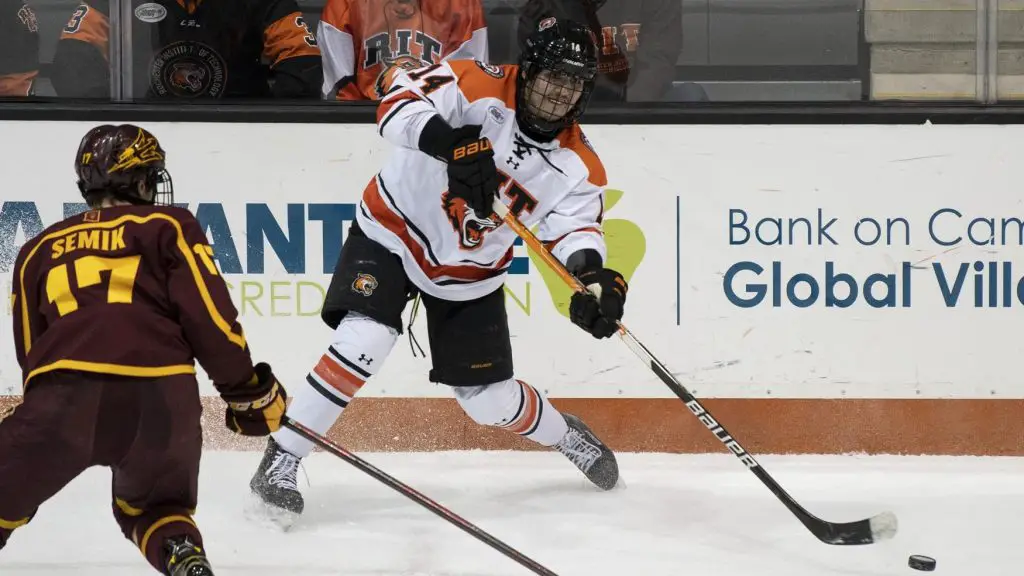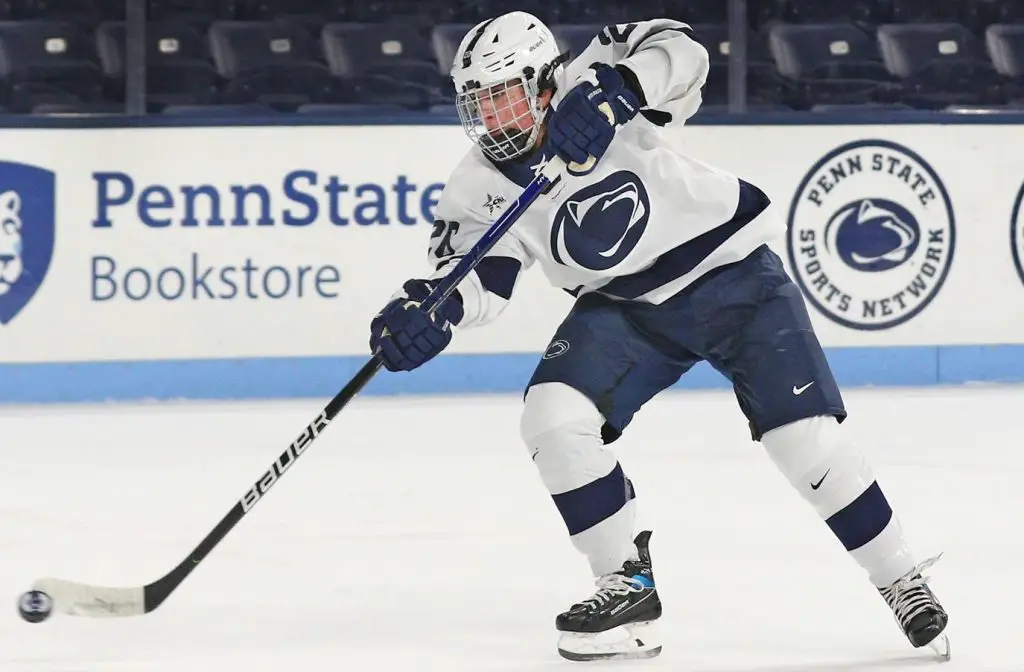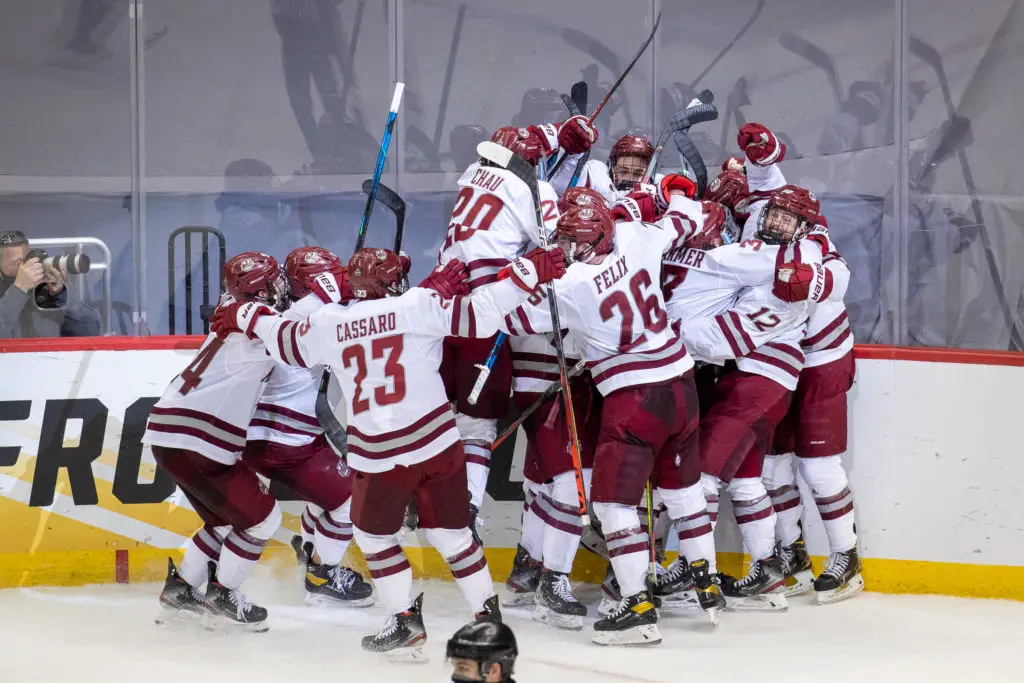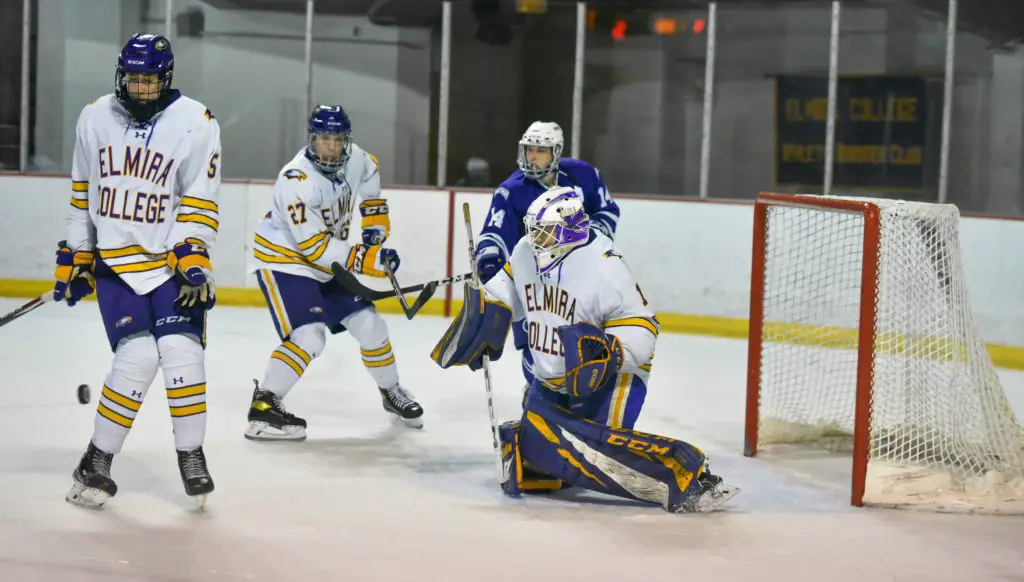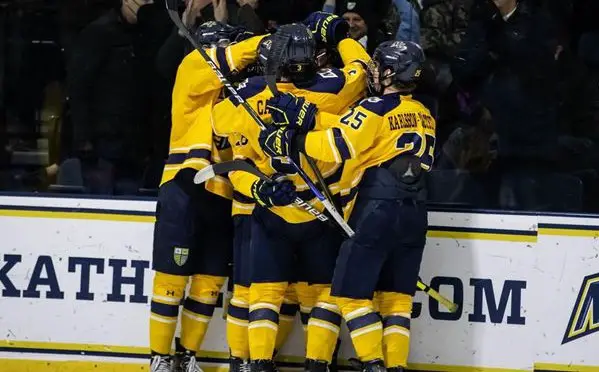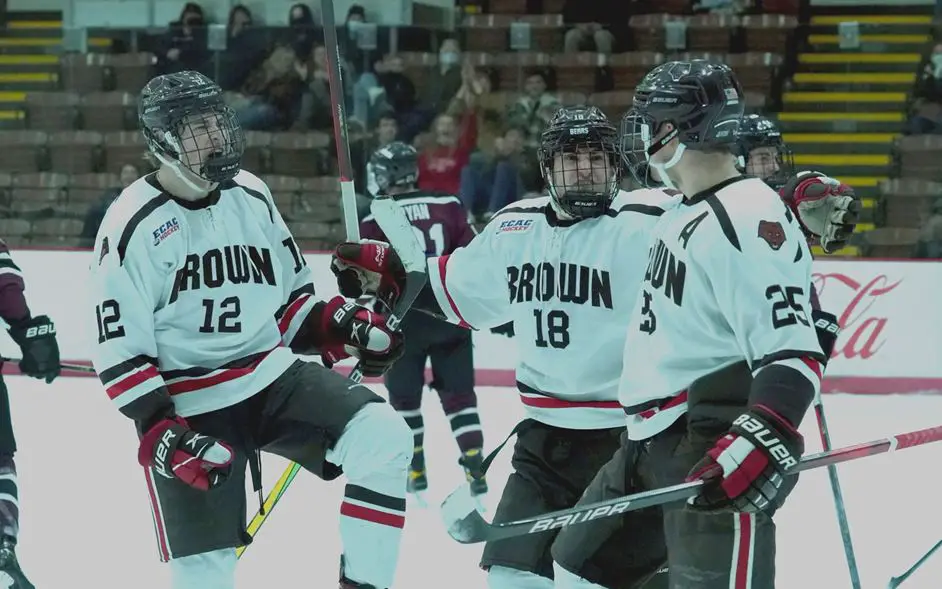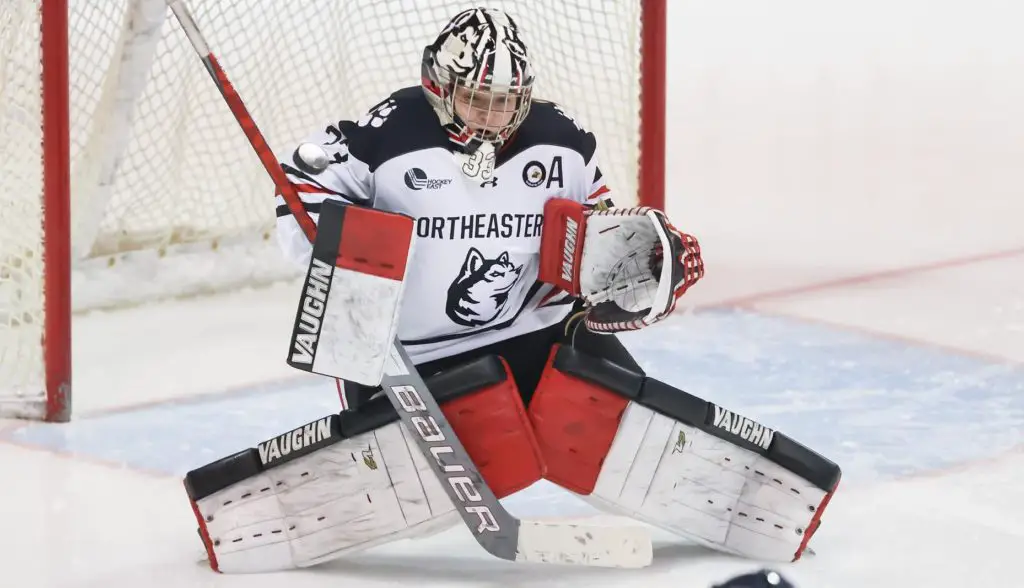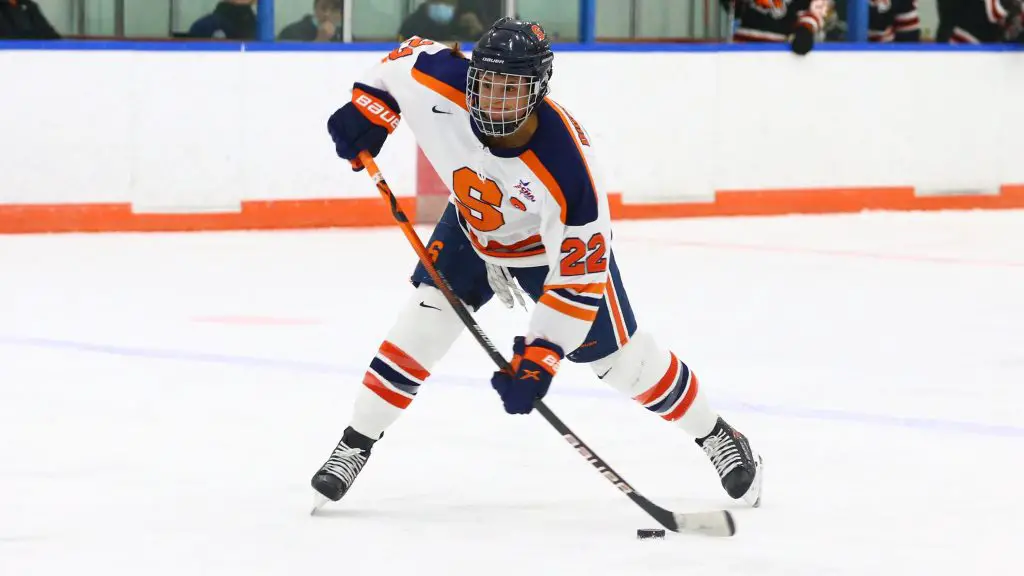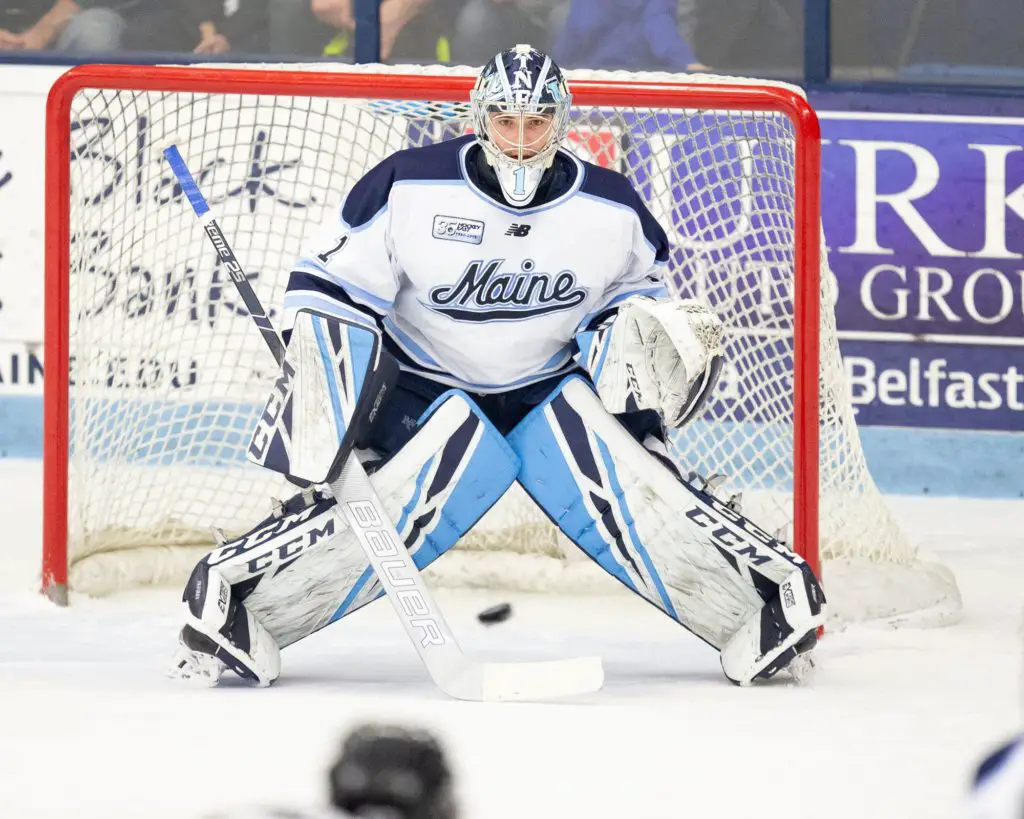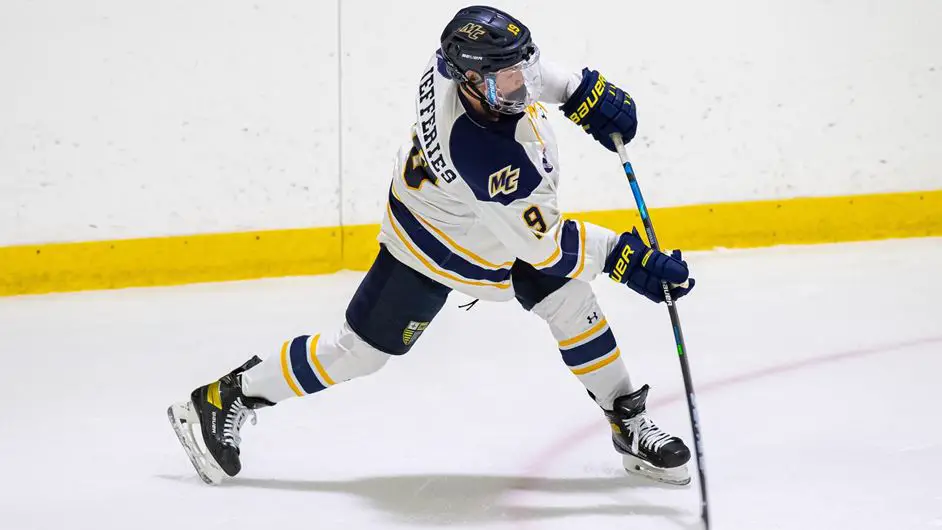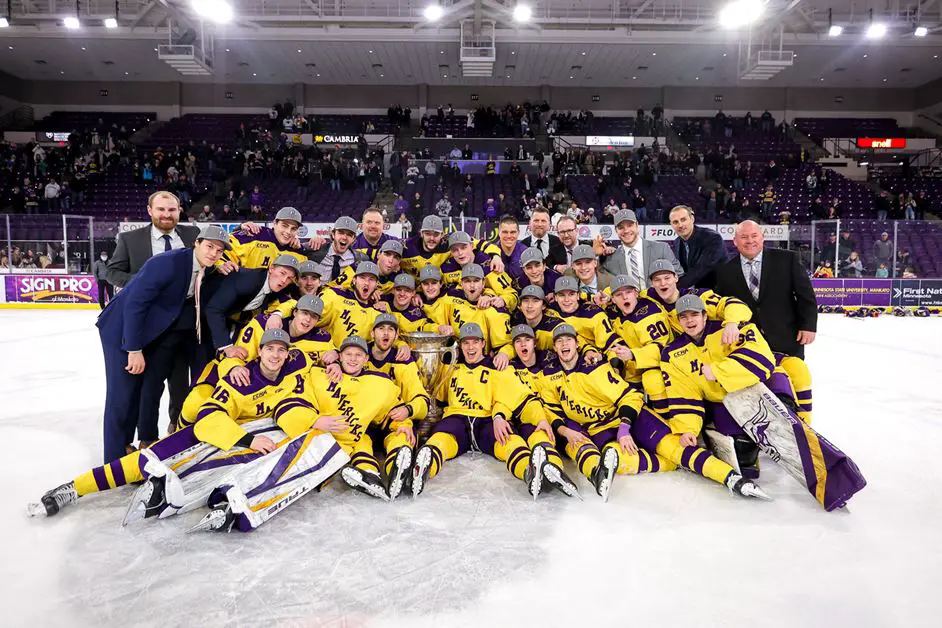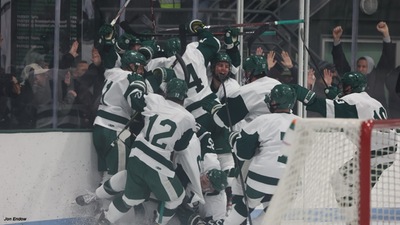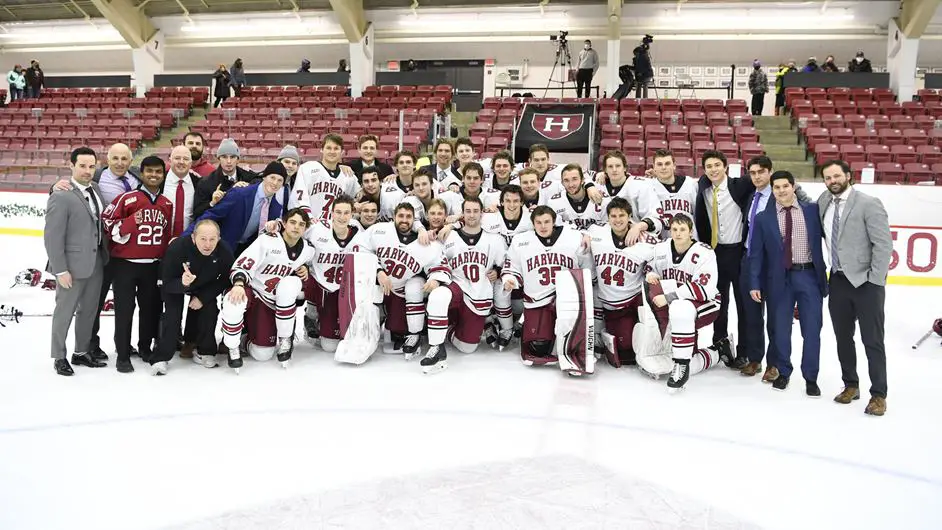Note: This is a special, part two, Thursday edition of Wednesday Women. Check out yesterday’s part one where Nicole, Arlan and guest columnist Grant Salzano talk about Pairwise, the new NCAA tournament format and which teams are affected.
Nicole: Ok, you two broke down the conference tournaments pretty well, so let’s lay it out. Who wins each one and who are your 11 NCAA tournament teams?
Arlan: A couple of weekends back, Mercyhurst and Syracuse played a series with the CHA season crown hanging in the balance. The Lakers won the opener, 9-0; the Orange took the rematch, 4-1. And you’d like me to predict who’s going to win that league’s tourney?
Sure. Why not? I will go with Syracuse, not because they are much more than a coin flip in any final, but because the Orange were a combined 7-1 against their possible semifinal opponents. A team has to reach the championship game in order to win it.
The WCHA doesn’t look to have a similar less-challenging route to the final, so I’ll pick Ohio State. The Buckeyes have been the steadiest team in the league over the course of the year, and had they not lost a game from their schedule due to Covid protocols, there’s a great chance that they would have gotten at least a share of the conference crown. If this doesn’t seem like an upset to you, consider that since UMD won the WCHA Championship in 2010, the Buckeyes tournament win in 2020 was the only league trophy to go to someone other than Wisconsin or Minnesota.
Maybe Northeastern gets dumped in Hockey East, but probably not. And picking that upset means I then have to find some other team capable of winning at least three games in a row. I’m lazy, so Northeastern.
I’ve put it off as long as I can. In the ECAC, forget about which team has the easiest semifinal. The first challenge is to pick a team that can make it out of the first round. I don’t see Princeton winning twice at Harvard. In the other three series, I can talk myself into predicting an upset fairly easily. I’ll take Harvard to earn another trophy. However, a part of me will be rooting for Cornell, after the Big Red were denied the 2020 tournament where they’d have been the top team.
Since I didn’t pick any wild upsets, that makes my NCAA field the top four teams in the WCHA, the top five in the ECAC, and Northeastern – the top 10 teams in all of the rankings – joined by Syracuse.
What do others see differently?
Nicole: I truly love the unpredictability this season has brought, both because it’s fun and because I think it’s good for the game. And with all those interesting outcomes and upsets, I have to believe we’ll see at least one or two happen in the postseason.
I’m probably picking a bit more with my gut than would be wise, but I think Yale takes the ECAC tournament. Not only do I have faith in them as a team, but as we’ve discussed, their position is quite precarious. They’ve had an unprecedented season for their program and I see them playing with their backs against the wall. They have to handle this like it’s win or go home and I think that makes the difference for them.
I’m picking Ohio State in the WCHA because I frankly just don’t see any flaws. By all rights, they should have seen a dip with Brändli in Beijing, but Amanda Thiele stepped up big time. There simply aren’t a lot of flaws on the Buckeyes. They have built as the season has progressed, exactly as you’d want your team to. They are stellar on special teams, get scoring across their lineup and are just heading into this postseason with all the momentum and confidence. The way this program has improved and built over the past few seasons, they feel a bit inevitable to me.
I think it’s probably Syracuse’s CHA tournament to lose, but I also think that Penn State has the team that can make the run to the autobid. Despite not having the season they would have liked after last year’s sort of breakout, I think their eyes have been on an NCAA bid all year and they have the pieces to make it happen. It feels like none of the CHA teams have put everything together all the same time. If any of them can make it all work in unison, I think the tournament crown is available for the taking.
It’s probably absolute nonsense to not pick Northeastern to win the Hockey East title. That being said, I’m pulling for Vermont. No offense meant to the Huskies, I just love watching programs grow and it has felt for me like the Catamounts have been on the edge of taking the next step for a few seasons. It has all come together well for them this year and Jessie McPherson is a goalie that can (and has) absolutely steal a game. The one-and-done format of this tournament plays in their favor in this way.
As for the NCAA tournament field? It’s obviously dependent on how they do, but my gut says Vermont is in over Clarkson, who were just too inconsistent at times this year. That’s probably the only surprise-type scenario.
Having watched the Badgers just absolutely struggle the past couple of weeks, I think they played themselves out of hosting a regional. They were playing with just 16 skaters in Columbus, which is hard when you’re playing lesser teams than Ohio State, much less in that situation. But the worrisome thing was all the mistakes happening that had nothing to do with how many lines they ran. Veteran players were making silly turnovers, passes were all over the place and they looked so far from the team that swept OSU earlier in the season. The Badgers have had a few bobbles in the closing weeks of the season and none of them became the wake up call that seemed to snap them out of it or activate any sort of “we’re better than this” response. Maybe they’ll prove me wrong in Minneapolis, but it’s hard to hold on to that hope for Badger fans right now.
Grant: Hey now, let’s give a shout to the NEWHA too! The conference has been pretty fun this year, with Franklin Pierce and LIU going to the wire to determine the regular season title – the two teams just split the season series. Both teams have done an awesome job bringing the fight to St. Anselm, who prior to the NEWHA’s formation had looked like a juggernaut without much competition. The conference will have an automatic bid to the national tournament next season, so it’ll be interesting to watch the prequel. Give me Franklin Pierce to win this one.
Nicole: It has! I found myself wishing last week that they didn’t have more regular season left to play. It would have been great for that LIU/Franklin Pierce series to be the final decider! As it is, my hope for NEWHA is that the games get easier to watch and more accessible.
Grant: The CHA has a pretty nice battle going, too, among its top three. Penn State, Mercyhurst, and Syracuse are in 18th, 19th, and 21st in KRACH – so normally I’d go with whoever’s hot, but in this case that would be none of them given that they all split on the final weekend. If you’re going to make me pick, I’ll take the Orange just by virtue of them getting to play the tournament on home ice.
Hockey East… oh, Hockey East. With the single elimination bracket everyone’s going to expect extra chaos, but to me this feels like one of those times where the expectations don’t pan out. I’m going to go as far as saying the entire bracket will be chalk – top four in the semifinals, top two in the final, and honestly, I don’t think anyone really puts too much of a scare into a full-strength Northeastern, I’m sorry to say.
I really don’t want to have to pick either of the last two conferences. I truly have absolutely no idea. In the WCHA, Minnesota gets to have home ice again (where’s my side-eye emoji…) so that could be a factor, but I’m pretty impressed with how the Buckeyes handled Wisconsin. I know the Badgers aren’t exactly playing on all cylinders, but they still have all kinds of firepower. If anyone seems to have an edge at the moment, I would give it to Ohio State.
The ECAC is radioactive. Quinnipiac just beat #4 Yale and lost to Brown in the same weekend. Harvard got to play a couple easy games to close out the regular season, so they didn’t have to show much. Yale’s resume has been quite good when they haven’t had to play the Bobcats.
I’m a bit partial to Quinnipiac this year. They have a pretty nice quality win bonus thanks to their performances against top teams this year (they really hung with Wisconsin up in Madison, too). I think I’ll take the Bobcats by virtue of that. They won’t have to worry about losing to Brown in the tournament!
Nicole: In my sleepless Olympics delirium, I definitely said to Grant that I wouldn’t want to play Brown in the postseason and he kindly reminded me that they didn’t make the postseason. That’s a shame, honestly, because I love watching teams with nothing to lose and everything to gain. Brown absolutely made a statement this season and I can’t wait to see what else they do in the coming years.
You make a good point that for all my talk of upsets and chaos that it will probably be straight seeds across the board. That would be so disappointing after the season we had, but I suppose it’s also pretty likely. But a girl can dream.
Watching the Ohio State vs. Wisconsin game on Friday, the OSU student announcers could not stop mentioning how Sophie Jaques could be the second-ever defender to win the Patty Kaz. I’m not at all convinced the committee will ever get behind a defender ever again, but Jaques’ case is probably one of the best we’ve seen since Angela Ruggiero was the first blueliner to earn the award.
On top of being one of the highest scorers in the country, she’s filled the gap on defense that Ohio State was missing after Jincy Dunne graduated. She doesn’t get flustered. In that conference, the defense is going to get challenged, but she keeps calm and doesn’t make stupid mistakes. She forces turnovers and creates opportunities quickly for the team to transition.
For me, Jaques is a given for the Patty top 10 (and very likely top 3, as well). Taylor Heise is also on that list, as is Daryl Watts and Alina Mueller. I’d also put Vermont’s Theresa Schafzahl and Yale’s Elle Hartje, both of whom are among national leaders in points per game.
From there, it gets a little more fuzzy for me in terms of how to separate or decide between players like Elizabeth Giguere, Gabbie Hughes, Abigail Boreen, Casey O’Brien, Makenna Webster and Kalty Kaltounkova. And that’s just keeping that list short for space sake – there are probably about 12 women that I feel are pretty closely bunched together and it would be pretty easy to convince me about any of them.
How about you guys? Are there any players that really stand out to you that you think are a lock for top ten or top 3 for the Patty Kaz?
Would you put any goalies on your Patty ballot this year? And who is your front runner or top 3 for the second-ever Goalie of the Year?
Arlan: Regarding Jaques, last year, she had only three points at the time and still made an All-WCHA Team. She is someone who is recognized for what she brings to the defensive side of the game. Obviously, when someone doesn’t put up any numbers at all, they aren’t going to be in the Patty Kaz conversation. I do see Jaques as having the type of season that we don’t always see from defenders. She anchored her team’s defense, while still contributing offensively. Most importantly, she doesn’t sacrifice her defensive responsibilities in order to do so. At awards time, I think that you can only go so wrong if you pick the best player on the best team. Jaques leads the country in plus/minus, she’s second to Heise in points per game, and I think she’s a big reason why Ohio State keeps reaching uncharted territory for its program.
As far as a comparison of Heise versus Watts, I think Watts is the better pure scorer. She can place her shot as effectively as anyone in the country, but what I’ve always felt is her greatest strength is that she can find the dead space in a defense and wait for someone to get her the puck. Heise is stronger when it comes to making other players better. O’Brien and Webster teamed with Caitlin Schneider to propel Wisconsin to the title last year, so I think that they could be effective on a different line. I don’t see Abigail Boreen and Catie Skaja reaching the 50-point and 40-point marks, respectively, if they weren’t skating with Heise. As a center, Heise also carries a greater defensive load.
However, I think the forward conversation goes much deeper. Great as she is, Mueller just missed too much of Northeastern’s season to rise higher than top 10. I agree on Schafzahl, who is the first Vermont player since Amanda Pelkey to be worthy of mention. As for Hartje, it’s nice to reward players who selected a school that was nowhere close to contending and made things happen there.
As for goalies, I don’t have strong feelings regarding any of them when it comes to the Kaz. Frankel makes the list, but I don’t think she can repeat when her numbers, as well as those of her team, have dipped from last year’s level.
To circle back to the Ohio State student announcers, the play-by-play announcer spent a minute before the start of Friday’s game summarizing Kennedy Blair’s college career and her path to Wisconsin. When he was done, the color guy said something along the lines of, getting the start in goal for the Badgers is Kennedy Blair. I definitely considered the source when listening to him rave about Jaques, but I think she’s the best choice despite that.
Nicole: If I didn’t know better, I would think those two had no actual contact to one another with how often the color guy repeated, contradicted or ignored what the play-by-play guy said. Bless their hearts, but it was a tough listen.
Arlan: Grant, who do you like, or have you taken a vow of secrecy?
Grant: Sadly, my two years on the Patty Kazmaier committee have come to an end. It’s a shame my two seasons coincided with the two years that COVID canceled the Kaz banquet… alas.
Most of the big guns are from out west this season, and I think that’s pretty deserving since I think the extra production against the extra difficult competition is worthy of mention. Last year when Frankel won it was a little bit of a special case since she set all-time goaltending records – weaker competition or not, there wasn’t much more she could do.
For me, given what I’ve heard of Sophie Jaques, she’s the winner, for me. I know Heise and Watts have put up a lot of points, but that happens every year. There are great seasons, and there are truly special seasons. I think Jaques’ year has been in the latter category, and she’d probably be in the final three with the numbers she has even if she was a forward. With all the talk of how much of a complete defender she is beyond just her scoring ability – I would have to point my now-nonexistent Patty Kazmaier vote in her direction.
Nicole: Arlan and I talked Olympics before they started and since then, the whole tournament played out. The Canadians were locked in and stellar to watch. The gold medal looked to be theirs from the first puck drop. On the other hand, it was a disappointing outcome for the Americans in Beijing. It’s not just that they lost, but how disorganized the team looked. There needs to be a lot of reckoning happening at USA Hockey about how much better Hockey Canada used the past four years and handled the pandemic.
I’ve touted here how much the NCAA has become the de facto development tool for not just the US and Canada, but a number of countries across the world. I wrote a column before the Olympics about how many players across all the rosters are committed to, currently or have played in the NCAA. As an advocate of the women’s college game, I think this is something to be really proud of.
But taking a step back, this shouldn’t need to be the case. Individual international players have chosen this route and their countries have reaped the benefit, utilizing this route instead of actually actively putting time and money into developing their young players.
Despite it being a huge part of the demands of the women who threatened to boycott in 2017, USA Hockey has not seemed to make any big steps towards creating a development pipeline for girls that comes close to what it has for boys with the National Team Development Program. I’m willing to give some leeway due to the pandemic, but there were three years between USAH agreeing to the women’s terms and the start of shutdown where we didn’t see a lot of movement on this. Now things have been at a standstill for two years. Add in the cancellation of two straight U-18 Women’s World Championships (though this year’s is looking like it might be rescheduled) and it leaves a bleak picture.
Who are the next great players for the US Women’s National Team? I can name a decently long list of women I think have a lot of potential, but it’s hard to think of an American analog to Sarah Fillier right now. Many of the women I’m thinking of won gold as U-18’s, but have seen little to no time with USA Hockey since then. Or they were put on a roster only to spend the whole tournament watching from the bench.
Arlan: I totally agree with you here. There were complaints about the American roster – they’re too old, too slow, too bad at playing hockey. I have trouble thinking of players that could have been substituted onto the U.S. roster and shifted the balance of power. There are players who made an impact during their NCAA days, but I have no idea where their games are at now, especially after a few years of lack of participation in the NWHL and navigating through a pandemic.
Grant: I am of the mind that until we have a true, full-salaried pro league with full-time training, the league that best develops Olympic-level talent is the NCAA. That’s not to say that the players who graduate out of the league have some steep fall off, but the gap is not large (and in fact there is plenty of overlap) between the best college players and the current drinking-age Olympians.
For example, losing Brianna Decker early on was so unfortunate – both for the team and for the player – but was the drop down to Abby Roque who slotted into her line really that big? I don’t think that it was. I know this is a pretty bold take, but I’m serious. Was it even a drop? Roque is elite.
It’s a fun thought exercise to think about how an NCAA All-Star team would do in the Olympics. I think they’d easily be the bronze favorite and would absolutely win a non-zero number of games out of ten against the Canadian and American rosters as they’re currently constructed. Like, really, we’re going to say Daryl Watts doesn’t belong in red and white? She’s one of the best and most exciting players I’ve ever watched. Come on. That’s another topic for another article, though…
Nicole: I’m going to need a minute to handle the shock of you actually putting that in print! But you’re not wrong.
Part of what has been so frustrating about this for me is that while Canada was obviously very good, they weren’t without their holes or weaknesses. I’m not here to call anyone out, but there were places they could have been exploited. Joel Johnson claimed to be trying to exploit matchups – in fact, it seemed to be his only strategy in the gold medal game – but it didn’t work. And if he didn’t trust the players on his roster in player-to-player matchups against Canada in a gold medal game, why the heck were those players put on the roster in the first place?! He literally chose them! It’s absolutely bonkers to act like the players on the USA roster were not up to the task. All that individual talent and it somehow added up to less than the whole.
The usual trolls came out during the Olympics to suggest the imbalance in women’s hockey between the US and Canada and the rest of the world means the sport should be removed from the Olympics. This is where it can get a little tricky – the USA and Canada are so far ahead because their federations invest in those teams far more than in many European countries.
But it can also be true that the US and Canada (but specifically the US) have a long way to go to reach peak support. Both things can be true.
The North American federations support their women’s senior national teams better than any other country. AND they can and should be doing more.
Arlan: Is the difference between the North American and the rest of the world due to better support by federations, or is the bigger gain made by starting out with a much larger player pool? I think back to those development camps that USA Hockey used to like to hold over the Christmas break. Players would come back from those just beat up, and it would take a few weeks for them just to get back to the level that they were at before they left.
Centralized players always seemed to improve; I’ll give you that. But that is more a factor of taking a few months where hockey is your job, something the NCAA doesn’t allow. Beyond that, I feel like the college players have always shown growth throughout their careers. I think the NCAA programs do more for the growth of the game than any federation, as you said above.
Nicole: But wouldn’t it be nice if all the countries centralized and the women could, actually, make hockey their job? The problem with particularly overseas countries relying on the NCAA developing individual players is that’s simply not a viable option for every player. And it puts the onus on the player to take charge of their own development. It shouldn’t require a four-year commitment to move to America for a young woman to be able to get the kind of support on and off the ice that the NCAA provides.
But it’s impossible to ignore what an impact NCAA players are having on the international stage. Some of the numbers are skewed by how many collegiate players are on the two highest-scoring teams. But the bulk of points scored by teams like Switzerland and Finland came from women who played in the NCAA.
Throughout the games I kept track of all the scoring – goals and assists – NCAA players did in Beijing. Through the whole tournament, 177 goals were scored and 273 assists were given. NCAA players accounted for ~75% of those points, or 131 goals and 200 assists.
Players with ties to Wisconsin led the way with a total of 41 points tallied. They led the way with 18 goals scored. Minnesota players were responsible for 37 points and led everyone with 25 assists. Clarkson players accounted for 35 points and Cornell players racked up 29.
For me, most notably – and most upsetting and depressing – women who had attended the University of North Dakota, who cut their women’s hockey program in 2017 – accounted for 11 goals and eight assists for 19 points. It was the 10th highest total of the 31 universities represented in Beijing.
]Arlan: I found it fitting that the best of those former UND players was Finland’s Susanna Tapani, who after one year in Grand Forks bailed on the Flighting, I mean Fighting, Hawks before they could bail on her.
